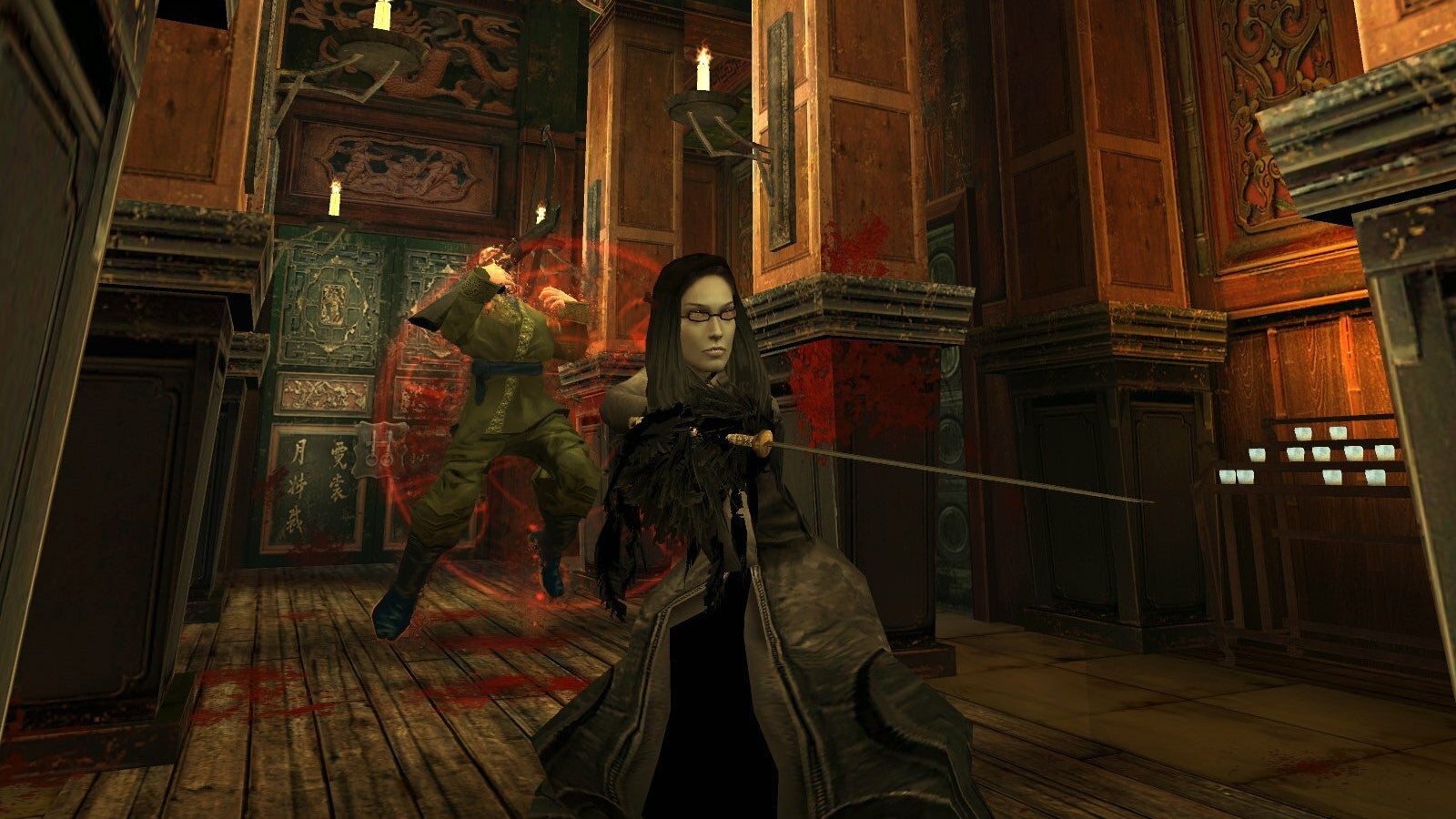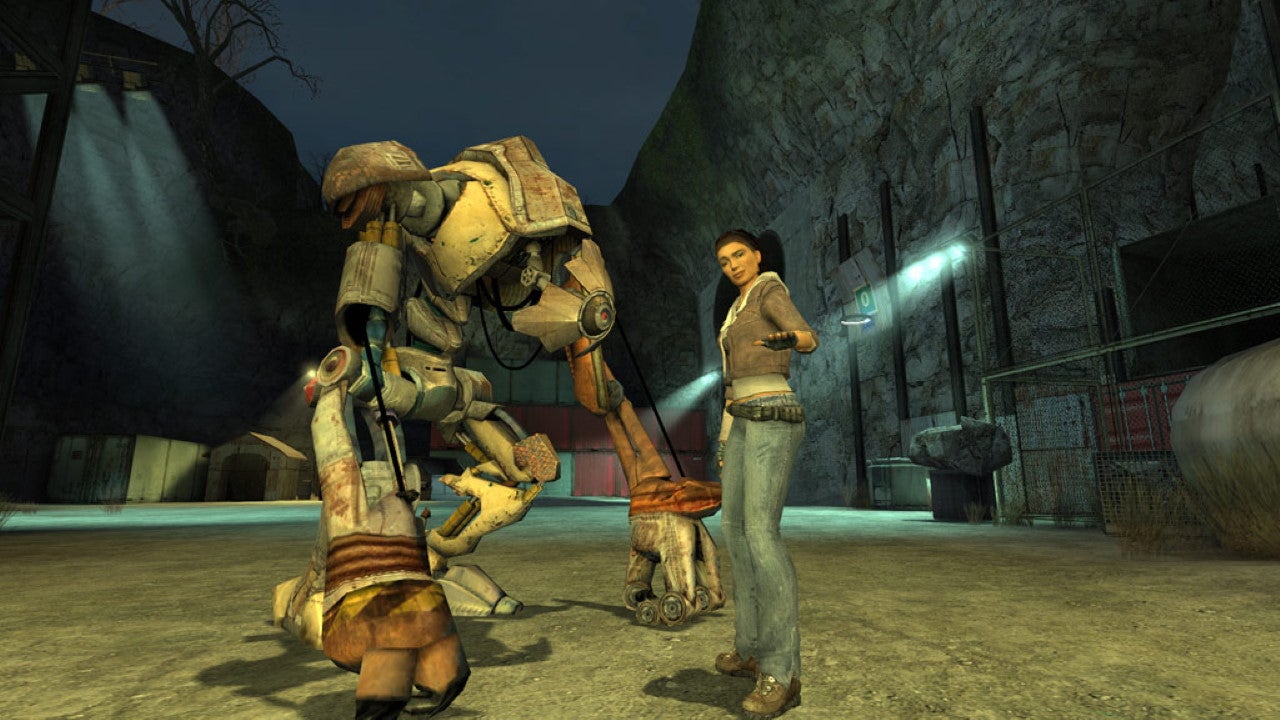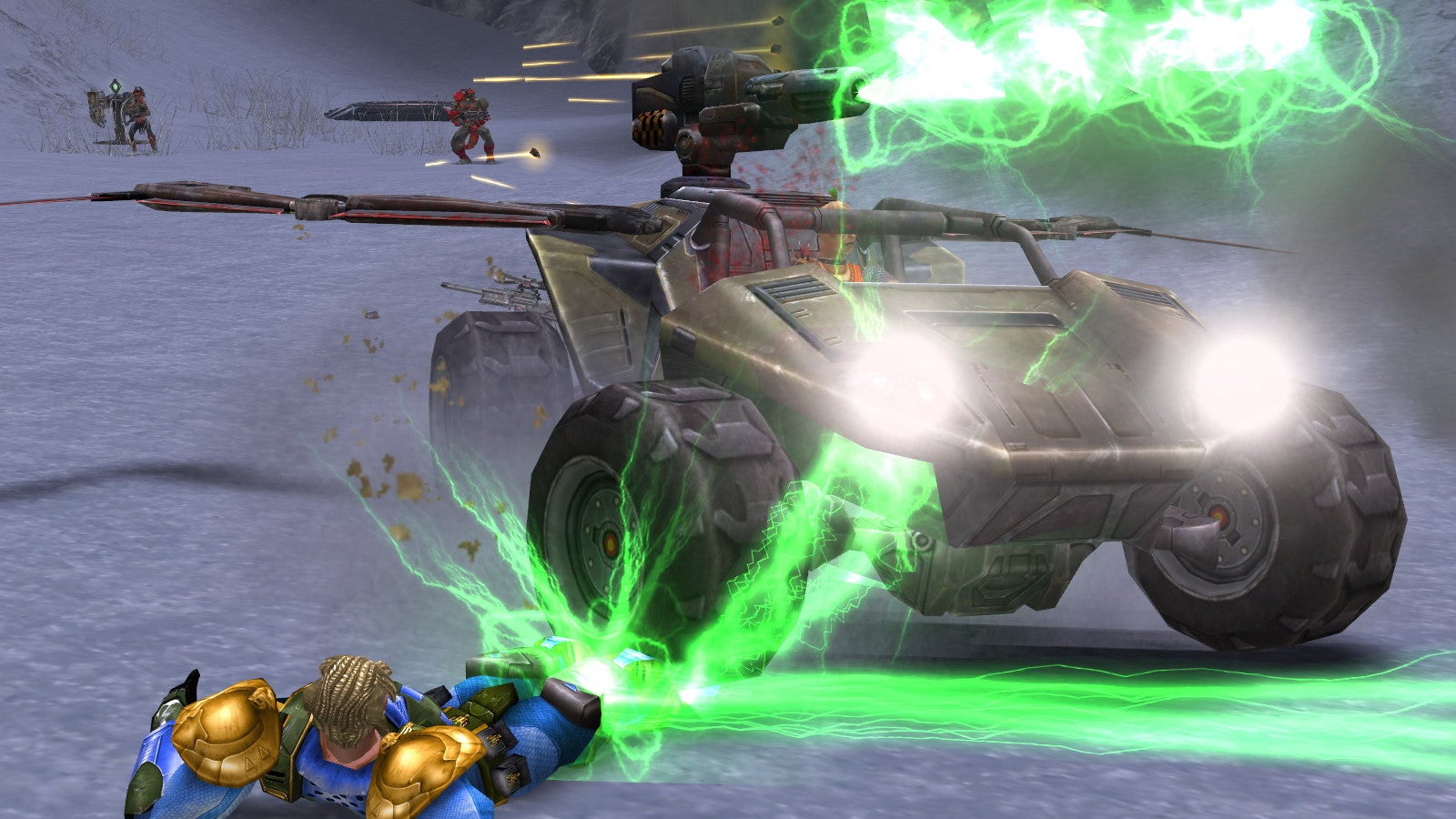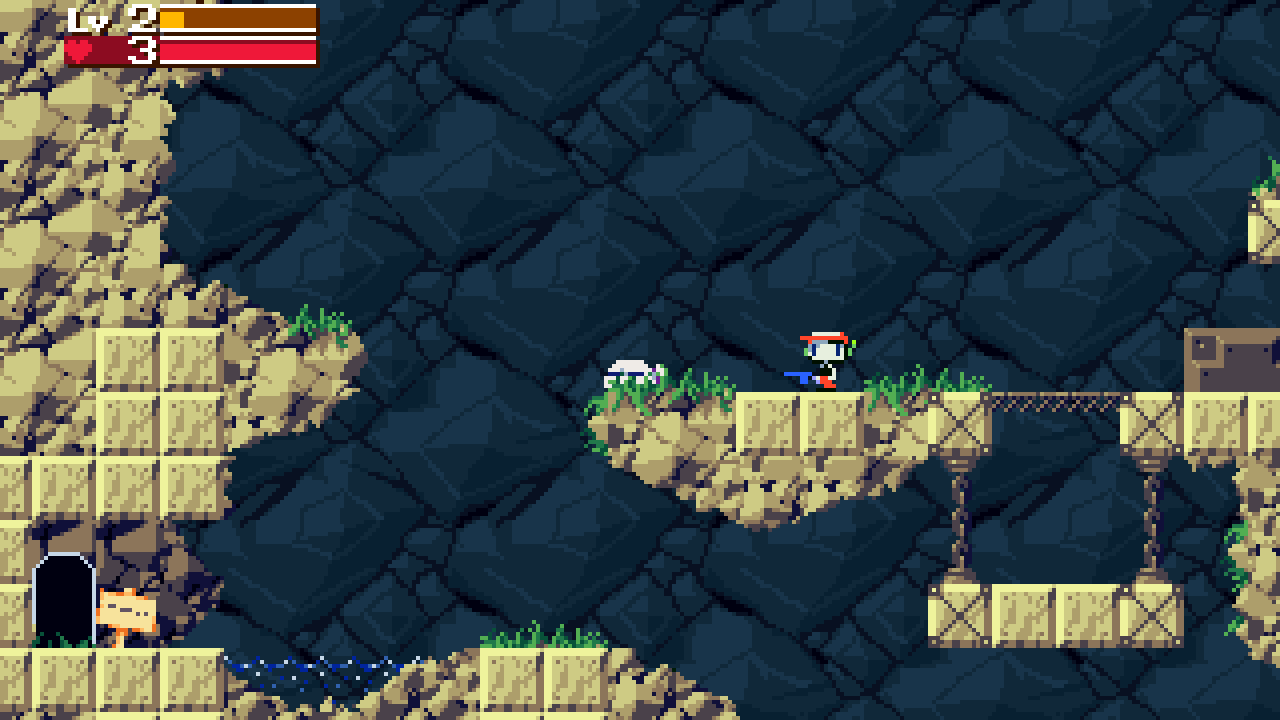Here are the rules. Like last time, these Time Capsules aren’t intended to be a definitive list of the best games from any given year. They’re all personal favourites, but the most important thing is that they’re all games we’d recommend people play today. They might be the best example of its genre, or they contain some kind of valuable lesson for future generations of game designers. It’s also this specific version we think people should play, too, so remasters and remakes may mean that certain games are missing from their original release year (and we’re going by PC release dates here, naturally, not when they first came out more generally). Think we’ve missed something important off the list? Tell us about the one game from 2004 you’d save from the heatdeath of the universe in the comments below.
Vampire: The Masquerade - Bloodlines
Alice Bee: Regular readers of my pointy-tooth-themed trash takes will have expressions of complete unsurprise to see my pick for the ‘04 capsule. But it’s not like this would be a controversial choice, right? Bloodlines is a beloved game, despite – or perhaps, because of – all its oddities. In Bloodlines, you play as a brand-new vampire stalking the streets of Los Angeles. You pick your clan of vampire, and thus the vampire powers you wield. You get into many a scrape, you find many a MacGuffin, you suck many a neck. Admittedly, it doesn’t sound very revolutionary when you boil it down like that, and Bloodlines also has the added problem of feeling pretty jank in the Source Engine (especially when it slips into third person), and it needs so much patching to run these days that it’s basically all patch. So what gives? The thing is, Bloodlines offers so much choice – so many ways for you to succeed or, indeed, fail – that it’s still one of the truest RPG experiences on PC. You really do get to play that role how you want. Until you get railroaded into gunfights a bit later in the game, you can go basically zero combat. You can sweet talk your way through problems, or explore and find shortcuts into buildings where you can find passwords for door codes. Add to that the writing, which makes characters feel really alive in that they’re as likely to tell you to fuck off as they are to say hello, and some amazing set pieces, and the fact that it somehow feels like a really sexy game even though all the character models look like haunted parking inspectors… it’s a really heady combination. Honestly, if one of us didn’t pick Bloodlines we’d be in for it. Happy to take one for the team, in this case.
Half-Life 2
Katharine: I mean, obviously, right? No capsule from 2004 would be complete without Valve’s masterclass in first-person game design. Half-Life 2 wasn’t just a revolutionary first-person shooter, whose physics and wibbly gravity gun shenanigans changed the way we thought about trad, old shooty-bangs forevermore. It also taught us that AI companions could be good, cool, believable friends; that cutscenes didn’t have to bore you to tears or wrest control away from the player; and that stories can play out over huge, interconnected spaces where bullets were just as deadly as a serrated sawblade. The fact it keeps cropping up on best lists even today - from best FPS games to more esoteric things like best companions, best dogs, best worst neighbourhoods, heck, even best vending machines - is a testament to its import and staying power all these years later. Heck, I didn’t actually play Half-Life 2 for the first time until several years later - around 2012, when I finally got a laptop capable of rendering 3D graphics - and even then it absolutely blew my socks off. I can only imagine the impact it must have had at the time, and I’m sure if I had a working PC back then, I would have instantly cast off my Pokémon-encrusted Game Boy Advance and never looked back. Half-Life 2 is just one of those games that manages to be everything at once. A thrilling action game, a tense horror experience, a fly-by-the-seat-of-your-pants racer, a rip-roaring sci-fi romp, a detailed physics simulation… It ticks every box, all with the effortless ease and confidence of a studio at the very top of their game. Seriously, attempting to get through Ravenholm without firing a single bullet to get the Zombie Chopper achievement remains one of my favourite and most memorable gaming experiences to this day (and it still eludes me, goddamnit, as I always find myself backed into a corner with no choice but to whip out my shotgun because my last sawblade pinged off to goodness knows where and I don’t want to erase valuable hours of progress). I’ll get there one day, but until then, anyone for a game of hoops with Dog and Alyx?
World Of Warcraft
Ed: I used to have a tatty World Of Warcraft Prima guide I’d flick through, even though I didn’t own the game at the time. This was how desperate I was to graduate from Runescape to a fantastical adventure that promised my young self a definitive MMO experience. One with snazzy visuals where you’d get to play as a dwarf hunter or undead rogue and make something of yourself in an Azeroth practically spilling over with players. Back in those Vanilla days, World Of Warcraft didn’t have baggage. Azeroth was vast, but not like, home to countless regions and isles and such. It was less streamlined, too. No entering menus and teleporting over to dungeons in a flash. You’d have to find folks and send whispers, then hop on your mounts and meet outside. I liked that it encouraged me to step out of my shell and interact with folks. My first ram mount cost me everything, too! And it only unlocked at level 40, a whole 20 levels later than WoW nowadays. Mainly, though, levelling was slower in Vanilla WoW but encouraged exploration. Instead of barreling through Azeroth, you’d spend more time in its nooks and crannies, squeezing EXP out of every little sidequest. Each ding! felt like a real milestone. Thankfully, World Of Warcraft Classic is still around and I’d highly recommend giving it a go if you’re after an MMO that’s a time capsule in itself. It captures World Of Warcraft as I remember it best, an MMO adventure that set the benchmark.
Star Wars: Battlefront
Hayden: While I adore Battlefront 2 old and new, I still end up playing the original Star Wars: Battlefront the most. You don’t play as the heroes or fly around in space. Instead, you play as a regular old trooper on some of the best maps I’ve ever seen, running around to capture command points and kill the enemy team. Rhen Var: Harbor and Tatooine: Dune Sea are stone-cold classics that I still swoon over today, and simply gunning down droids as I ran around as a clone was mesmerising for little me. At first, I found it odd that I gravitate towards Battlefront 2004 over the sequel, considering Battlefront 2 largely seems like the same game with a bunch of minor and major improvements, but a bit of time spent hopping between the two made me realise that it isn’t just nostalgia. In the original Battlefront, the battles feel more compact and contained, with air vehicles able to swoop down and attack land troops between dogfights. The AI also felt stronger in the first game, which made every match of instant action a challenging experience. The lack of playable heroes also makes vehicles much scarier. Without a lightsaber, an AT-ST is a terrifying beast that could turn the tide of the battle in seconds if you don’t start planning a counterattack. While Battlefront 2 does a great job of portraying flashy battles with space cruisers and force users, Battlefront 1 is best at making you feel like part of Star Wars at its most basic and exciting level. You’re just a regular rebel soldier desperately fighting to protect Echo Base from the Empire, with no chance to just become Luke Skywalker and destroy the enemy team. That’s an experience that I definitely want to preserve.
Unreal Tournament 2004
Liam: More games should have a Lightning Gun. What a brilliant idea for a weapon. It’s a sniper rifle, right, but (and stick with me on this one) instead of shooting bullets it fires - wait for it - a bolt of lightning. The fury of Zeus himself, distilled into a single beam of instantaneous death. There’s none of this “bullet drop” nonsense when you’re wielding a Lightning Gun. No holding your breath to steady your shot. There are just three simple steps: Click. Crack. Death. This simplicity is the green luminescent blood that runs through the rusty cyborg veins of Unreal Tournament 2004. In the modern era, where multiplayer experiences are as defined by their time-gated seasonal content and endless battle passes as the actual game itself, Unreal Tournament 2004 feels like a breath of fresh air even today. As a package it’s little more than a collection of classic multiplayer game modes. Your deathmatches. Your capture the flags. Etc. It’s all loosely framed as a futuristic space tournament where lizard monsters and space Pharaohs shoot each with rocket launchers, but the context doesn’t really matter. What matters is the pristine moment to moment gameplay, resulting in a white-knuckle thrill fest that only an early 2000’s twitch shooter can provide. Admittedly, outside of the addition of vehicles, there’s not a huge amount of stuff in UT2004 that can be described as unique. Quake 3 Arena and even UT2003 are comparably brilliant alternatives that hit largely the same notes. UT2004 was simply the last of its kind, a pure and simple take on the genre that has remained unmatched in the 18 years since its release. Unreal Tournament 3, appearing a mere three years later, attempted to prove itself as a worthy successor but by replacing its early-2000s cast of sunglasses wearing techno weirdos with a bunch of late-2000s meat men, it ultimately fell short. Unreal Tournament 2004, meanwhile, is still a joy to play. A true classic worthy of preservation, if only for the inclusion of that beautiful, uncompromising Lightning Gun.
Cave Story
Alice0: Looking back at 2004’s games today, it looks a strange and empty year with only a handful of notable PC games. PC gaming was in a very different place. It’s a year I mostly spent playing mods for older games, hours of Natural Selection for Half-Life and maybe Warcraft 3’s DotA by then too. While I didn’t know it at the time, these were heralds to the vast world of PC gaming as we know it now, with the NS mod team growing into making a commercial sequel and Valve buying Dota for a free-to-play live service sequel. Another glimpse of the future came in Cave Story, a freeware platformer made by lone developer Daisuke “Pixel” Amaya. That’s what makes 2004 look so weird to me: the relative absence of games made by single people or tiny teams. Filling a time capsule from 2014, I could think of a dozen such games I’d put in, but 2004 is before the birth of the indie scene as we know it. I feel Cave Story was a major inspiration on that, for both developers and players. A game made by a single developer was better than many made by whole studios, and people loved it. He proved it was possible and gave people a hunger for more. But influence and legacy aside, Cave Story simply was - and is - a good game. It’s fun, it’s funny, it’s charming, it’s challenging, it’s exciting, it’s pretty, it sounds great, it is great.
Sherlock Holmes: The Secret of the Silver Earring
Rebecca: I regard 2004 as my peak teenage nostalgia year, a status earned in no small measure by the fact that it saw the release of two of my all-time favourite video games: Vampire The Masquerade: Bloodlines and The Sims 2. But Alice Bee called first dibs on my beloved VTM:B, and devastatingly you can’t buy The Sims 2 anywhere any more, rendering it ineligible for inclusion in our time capsule. So instead, I submit one of the greatest gaming oddities of 2004, but one that I truly believe deserves to be saved from oblivion: Sherlock Holmes: The Secret of the Silver Earring. Frogwares’ Adventures of Sherlock Holmes series began in 2002 with The Mystery of the Mummy; its most recent entry was last year’s Chapter One. In total, there have been nine main titles to date, plus a handful of HOG and handheld spin-offs, and I love them all. Originally, I intended to submit 2014’s Crimes & Punishments to the appropriate module of the time capsule, on the basis that it’s generally agreed to be the best in the series. But then I got to thinking: C&P is good and all… but for what I come to this series for, specifically, it might actually be my least favourite. For me, Frogwares games are like Nic Cage movies: if everything’s too normal you’ll be left feeling slightly disappointed, no matter how technically well put together the production. And if it’s the platonic ideal of Frogwares weirdness that you’re after, you can’t beat the second game in this series, 2004’s The Silver Earring. If you’ve ever wanted a game to leave you really feeling like Dr Watson, The Silver Earring is unbeatable. You follow Holmes around a series of Victorian London stock locations as he enthusiastically hunts out piles of white powder (which he swears are clues) and reacts to discovering puddles of gin and blood with the exact same unnerving eagerness. His conclusions are completely impenetrable, but at the summation quiz that closes out every chapter of the game, he berates you like it’s idiotic that you couldn’t follow his moon logic. Delightfully, the script is based on an unpublished fanfiction novel, because of course it is. It’s a game that leaves me wheezing with laughter every time I play it, and to Frogwares’ credit, while this one may have been unintentionally hilarious, they quickly learned to lean into it in later entries. The people of the future deserve to have at least one jankily-3D, post-golden-age point-and-click that they can experience as a matter of historical curiosity, and I can’t think of a better example to preserve that special moment in gaming history.
Sid Meier’s Pirates!
Ollie: Sid Meier’s Pirates! is a special case, and I’m willing to bet I’m not the only person who feels this way. When you actually think about it, Pirates! is merely a collection of fairly simple minigames, sailing together under the banner of an open-ended tale of exploration, romance, debauchery, and plunder. And yet I’m not sure I’ve ever played a game that offers me such excitement at the prospect of starting a new save file, even after so many years and so many playthroughs. Perhaps leaving aside the buried treasure minigame, the other activities that form your life of piracy and adventure are all remarkably enjoyable even by today’s standards. If nothing else, their simplicity works to their advantage. They are as familiar as they are exhilarating, as comforting as they are dramatic. The sheer glee I feel when I’m sailing down the Spanish Main and I catch a glimpse of the fabled treasure fleet heading towards a major port… Ah, it’s just wonderful. Hunting down the top ten pirates in the Caribbean and defeating them in fencing duels; engaging in ship battles and manoeuvering your ship in the perfect position for a devastating broadside; Casanova-ing your way across the Mexican Gulf, trying to find the most beautiful governor’s daughters to dance with; all these are definitive gaming experiences of my childhood. Don’t mistake that simplicity for a lack of challenge, though. As time goes on, your character gets older, and they can’t move as quickly as they did in their 20s. Your overall goal - to track down the evil Marquis Montalban and save your long-lost family members - is a goal which requires a lot of work, and some of it can be very hard work if you play on the higher difficulty levels. And who can resist, when you see just how much straighter and more confidently your character holds himself as you flip through the different difficulty levels at the start of a new game? Magic.
Garry’s Mod
James: I guess technically this would have to be the original Source SDK experiment that snuck out in the last week of 2004; the standalone Garry’s Mod didn’t release until 2006. But if we’re having Half-Life 2 in the capsule, why not throw in its greatest mod? Sometimes I worry that all the gurning face poses and rocket-propelled ragdolls that GMod’s sandbox tools allow, if not encourage, might leave it dismissed as a toy for the wilfully stupid. That would be unfair. From humble beginnings, it’s grown to encompass almost everything that’s special about PC gaming: the openness, the willingness to experiment, the realisation of creativity, the ability to spawn in two hundred explosive barrels and shoot them until Windows crashes. And I know Watch Dogs marketing ruined the I word, but just look at gm_construct and tell me it isn’t iconic. What also separates GMod from other sandbox games and mods is the diversity of what’s been crafted with it. Later years would see enterprising users create entire games-within-a-game, like Trouble in Terrorist Town and Prop Hunt (the latter in particular has had its concept borrowed by several AAA games as side modes). Personally, I’ve wrung uncountable hours of enjoyment out of Garry’s Mod-created videos and webcomics, and I’m fairly sure there’s a mini-generation of animators who started posing GMod ragdolls and are now making much more polished material with more sophisticated tools. Many such GMod works are crude, and most of the older ones aren’t nearly as funny to me as a grown man as they were in my teens. But for the most part, I’m glad they exist, as I am for the myriad of other images, animations, comics, games, and minigames to which Garry’s Mod has given life. If that kind of creative spirit isn’t worth preserving, I don’t know what is.








